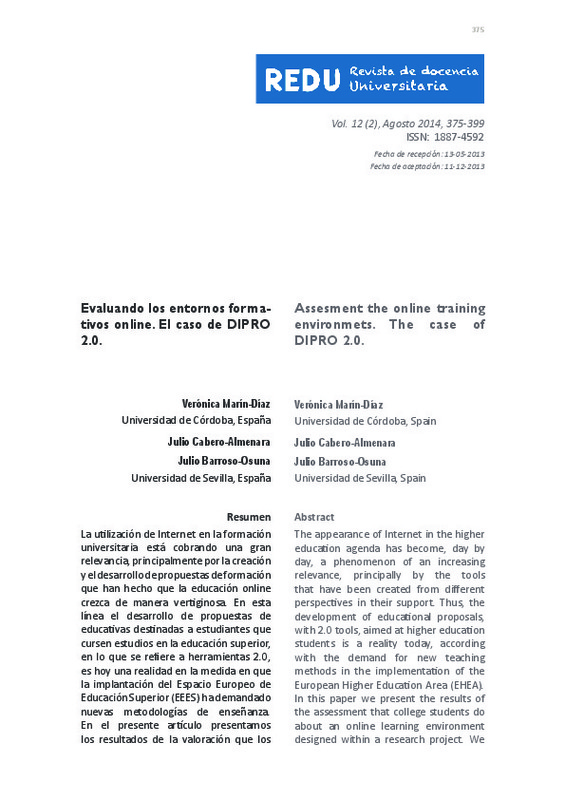Ahmadi, S., Keshavarzi, A. y Foroutan, M. (2011). The application of information and communication technologies (ICT) and its relationship with improvement in teaching and learning. Procedia Social and Behavioral Sciences, 28, 475-480. DOI: 10.1016/j.sbspro.2011.11.091.
Azizan, F. Z. (2010). The effectiveness of using internet as a principal information resource in teaching and learning activity in higher educational institutions in Malaysia. Regional Conference on Knowledge Integration in ICT, 7-12.
Cabero, J. (dir) (1993). Investigaciones sobre la informática en el centro. Barcelona: PPU.
[+]
Ahmadi, S., Keshavarzi, A. y Foroutan, M. (2011). The application of information and communication technologies (ICT) and its relationship with improvement in teaching and learning. Procedia Social and Behavioral Sciences, 28, 475-480. DOI: 10.1016/j.sbspro.2011.11.091.
Azizan, F. Z. (2010). The effectiveness of using internet as a principal information resource in teaching and learning activity in higher educational institutions in Malaysia. Regional Conference on Knowledge Integration in ICT, 7-12.
Cabero, J. (dir) (1993). Investigaciones sobre la informática en el centro. Barcelona: PPU.
Cabero, J. (dir.) (2004). La red como instrumento de formación. Bases para el diseño de materiales didácticos. Píxel-Bit. Revista de Medios y Educación, 22, 5-23.
Cabero, J. (dir.) (2006). Formación del profesorado universitario en estrategias metodológicas para la incorporación del aprendizaje en red en el Espacio Europeo de Educación Superior. Píxel-Bit. Revista de Medios y Educación, 27, 11-29.
Cabero, J. y Gisbert, M. (2005). La formación en Internet. Guía para el diseño de materiales didácticos. Sevilla: Eduforma.
Cabero, J., López, E. y LLorente, Mª C. (2009). La docencia y las tecnologías web 2.0. Renovación e innovación en el espacio europeo. Sevilla: Mergoblum.
Cabero, J. (2012). Tendencias para el aprendizaje digital: de los contenidos cerrados al diseño de materiales centrado en las actividades. El Proyecto Dipro 2.0. RED. Revista de Educación a Distancia, 32, Recuperado de http://www.um.es/ead/red/32.
Castañeda, L. y Adell, J. (eds.) (2013). Entornos personales de aprendizaje: claves para el ecosistema educativo en la red. Elche: Marfil.
Conole, G. y Alevizou, P. (2010). A literature review of the use of web 2.0 tools in Higher education. A report commissioned by the Higher Education Academy. The Open University Walton Hall, Milton Keynes UK. Recuperado de http://www.heacademy.ac.uk/assets/EvidenceNEt/Conole_Alevizou_2010.pdf.
Dilillo, D. y Gale, E. B (2011) To Google or not to Google: Graduate students' use of the Internet to access personal information about clients. Training and Education in Professional Psychology, 5 (3), 160-166. DOI: 10.1037/a0024441.
Domenech, J. (1977). Bioestadística. Barcelona: Herder.
Dunn, O. (1964). Multiple Comparisons Using Rank Sums. Technometrics, 6, 241-241.
Garrett, H. (1971). Estadística en psicología y educación. Buenos Aires: Paidós.
Gikandi, J.W., Morrow, D. y Davis, N.E. (2011). Online formative assessment in higher education: a review of the literature. Computers & Education, 57, 2333-2351. DOI: 10.1016/jcompedu.2011.06.004.
Huang, E. Y., Lin, S., W. y Huang, T. K. (2012). What type of learning style leads to online participation in the mixed-mode e-learning environment? A study of software usage instruction. Computers & Education, 58, 328-349. DOI: 10.1016/j.compedu.2011.08.003.
Infante, A., Gallego, O. y Sánchez, A. (2013). Los gadgests en las plataformas de teleformación: el caso del proyecto Dipro 2.0. Pixel-Bit. Revista de Medios y educación, 42, 183-194.
Kalikant, Y. B. D. (2012). Using ICT for school purpose is there a student school disconnect? Computers & Education, 59, 907-914.
Li, Q. (2007). Student and teacher views about technology: a tale of two cities? Journal of Research on Technology in Education, 39 (4), 377-397.
Llorente, M.C. y Cabero, J. (2008). La formación semipresencial a través de redes telemáticas (blended learning). Mataró: Editorial Da Vinci.
Marín, V. y Maldonado, G.A. (2011). El alumnado universitario cordobés y la plataforma virtual Moodle. Pixel-Bit, Revista de Medios y Educación, 38. 121-128.
Marín, V., Ramírez, A. y Sampedro, B. (2011). Moodle y estudiantes universitarios. Dos nuevas realidades del EEES. Profesorado, Revista de Curriculum y formación del Profesorado, 15(1). 109-120.
Osgood, Ch., Suci, G. y Tannenbaum, P. (1976). La medida del significado. Madrid: Gredos.
Pardo, A. y Ruiz, M.A. (2005). Análisis de datos con SPSS 13 base. Madrid: Mc Graw-Hill.
Percival, J. y Percival, N. (2009). A case of a laptop learning campus: how the technology choices affect perceptions? Journal in Learning technology, 17(2), 173-186.
Rodríguez, R. Mª (2005). ¿Cambia Internet los sistemas de enseñanza y aprendizaje?: Desafíos y posibilidades. Innovación Educativa, 15, 213-221.
Sabariego, Mª. (2004). El proceso de investigación. En R. Bizquerra. Metodología de la investigación educativa. (pp. 129-163). Madrid: La Muralla.
Siegel, S. (1976). Estadística no paramétrica. México: Trillas.
Steffens, K. (2006). Self-Regulated Learning in Technology-Enhanced Learning Environments: lessons of a European peer review. European Journal of Education, 41, (3/4), 353-379.
Uzum, L. (2012). The internet and computer-mediated artefacts for foreign language learning and practice, and intercultural communication: MOODLE, Second life and others. Procedia Social and Behavioral Sciences, 46, 3296-3300.
Van De Vord, R. (2010). Distance students and online research: promoting information literacy through media literacy. Internet and Higher Education, 13, 170-175.
Van Deursen, A., y van Dijk, J. (2011). Internet skills and the digital divide. New Media and Society, 13(6), 893-911. DOI: 10.1177/1461444810386774.
[-]








